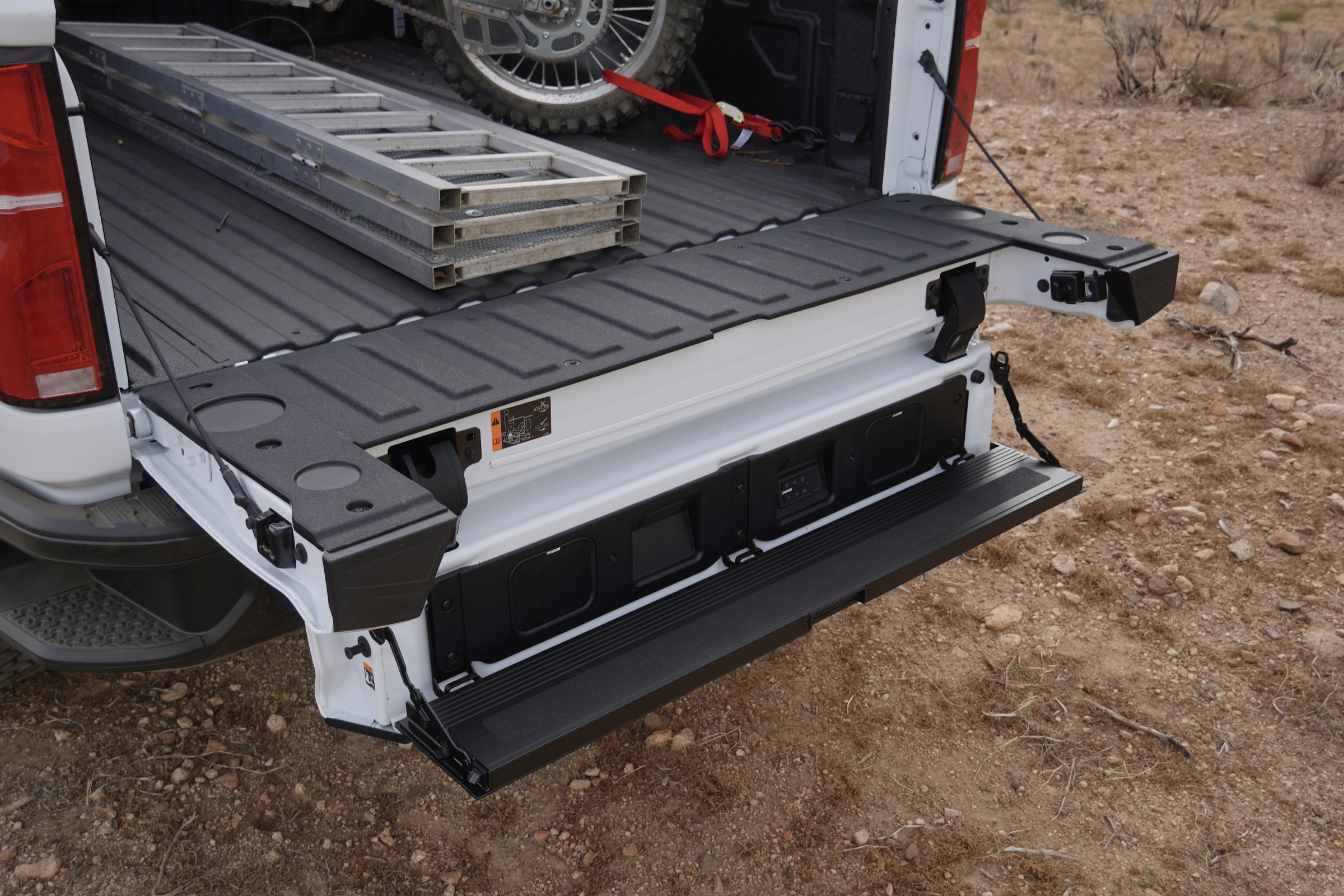For model year 2025, Chevrolet added the Trail Boss package as an option for the 2500-class Silverado Heavy Duty. Similar to the 1500 Silverado, the 2500 Trail Boss includes Z71 suspension upgrades, blacked-out bumpers with red recovery hooks, and 20-inch wheels shod in all-terrain tires.
A gas V8 comes standard, but the torque-monster Duramax diesel adds towing capacity. This helps the Trail Boss slot in as a somewhat rugged pickup that doesn’t cost or weigh quite as much as the top-spec ZR2 or Bison.
I recently spent a week with the diesel Trail Boss, logging plenty of miles in Los Angeles and the surrounding desert. Though the sheer size of the HD Trail Boss presented challenges in town, out on the highway this truck loves to cruise.
The beefy engine barely noticed long uphill grades with a dirt bike in the bed. And, the massive back seat let me pack in moto gear without feeling cramped at all. Sure, I missed the Multimatics of the ZR2, but the Trail Boss’s Rancho shock dampers surprised me, both on road and off.
In short: If the Silverado HD ZR2 and Bison simply look too big, heavy, and expensive for real life, then the Trail Boss might be for you. Adding this package to the 2500-class truck provides a more practical option for hauling the family, toys, and gear off the beaten path. On the other hand, optioning the Duramax diesel V8 still ramps up the price tag quite quickly. But overall, the latest Trail Boss fills a neat void in the Silverado lineup.
2025 Chevrolet Silverado HD Trail Boss
- Engine: 6.6L turbodiesel V8
- Transmission: 10-speed automatic
- Horsepower/Torque: 470 hp / 975 lb.-ft.
- MPG: 14 mpg city / 17 mpg highway (est)
- Top Speed: 114 mph
- Weight: 6,686 lbs.
- Dimensions: 250” L x 79.8” H x 81.9” W (w/out mirrors)
- Towing Capacity: 22,500 lbs.
- Bed length: 6.25' or 8'
- Starting price: $64,230 (gas), $74,720 (diesel)
Pros
- Seriously beefy diesel powertrain
- Spacious and tech-friendly interior
- Just enough off-road prowess to get off the beaten path
Cons
- Still a very big, very heavy truck
- Pricing hurts, especially with the diesel
- Not quite as off-road-ready as a ZR2
2025 Chevrolet Silverado HD Trail Boss Review

Diesel Torque
The first time I fired up a Silverado HD’s Duramax engine, the wonderful combination of a V8 and turbodiesel grumble brought an immediate smile to my face. I’m more accustomed to Cummins straight-sixes in Rams, as well as the aluminum inline-six in the 1500 Silverado. But this engine simply delivers unbelievable torque, seemingly forever.

Those 975 pound-feet make the Trail Boss a legit option for towing dirt bikes, side-by-sides, and campers out to campsites and OHV areas. And somehow, despite the 6.6L displacement, my loaner truck reported an average of 15.8 mpg over 447 miles of driving — and I believe that figure, since I never needed to fill up the 36-gallon tank and returned the truck with the fuel gauge at just under the quarter mark.

Impressive Ride for Mid-Tier Suspension
But the Duramax diesel isn’t really the point here, since we’ve known that engine for the past few years. Instead, I wanted to test the new Trail Boss package as a more affordable alternative to the top-spec ZR2 and Bison Silverados. I wondered beforehand whether the lack of Multimatic DSSV dampers might render the truck too uncomfortable for off-roading.
Keep in mind that Chevy’s 2500-class trucks are somewhat unique. Instead of a solid front axle, the Silverado HD uses independent front suspension with torsion bars. The rear axle stays leaf-sprung, though, rather than switching to coil springs. On the Trail Boss, Rancho shock dampers replace the ZR2’s Multimatics, looking much less substantial at first glance.

But in town, the Ranchos worked quite well. Speed bumps never caused too many jolts to realign my spine, and even the choppy 405 freeway seemed to dull down a bit. The Trail Boss’s steering also feels slightly lighter than I remember for the ZR2, possibly because of the BFGoodrich K03 tires on my loaner — the undisputed new champ of all-terrains.

The K03s contributed to a surprisingly calm cabin while driving the Trail Boss at highway speeds, too. The V8 purrs along at low revs happily thanks to the 10-speed auto, with minimal tire hum or wind rush entering the cabin otherwise.

Maybe the Trail Boss bumpers provide slightly better aerodynamics, but without a doubt, lacking the steel ZR2 pieces and underbody protection also helps this truck ride much more happily most of the time. For context, a ZR2 Bison with all of AEV’s add-ons can weigh as much as 1,800 pounds more. Even Multimatic’s awesome dampers clearly struggle with so much heft.
Off-Road

The limited refinement of the Trail Boss suspension showed up once I turned off the asphalt, though. At first, a washboardy graded road caused more shuddering than on a ZR2 or Bison, though not to an unpleasant or concerning amount.
And in some situations, where the Multimatics keep even the massive Silverado HD ZR2 Bison squared-up at all times, the Rancho shocks actually allow for a bit more body roll and cushion.
On the 2500, a Silverado’s four-wheel-drive controls sit on both the left and right sides of the steering wheel. So I spent a fair amount of time double-checking myself, certain the Trail Boss must surely come with a rear locker. And yet, it doesn’t — which is a bit of a bummer given the prospect of towing a toy hauler out into any slippery situations.

The full-size spare also does not match the BFGs, and even without the ZR2 and Bison off-roading bumpers, the Trail Boss doesn’t get Super Cruise.
Adventure Truck

The back seat gave me plenty of room to pack up moto gear without worrying about dirt getting all over anything I left in the truck bed. And clever storage behind the rear seatbacks looked perfect for stowing my tie-down straps.

It’s also great that Chevy includes three levels of tie-down hooks in the 6.25-foot bed, the shorty versus an optional 8-foot bed. As usual, the Multi-Flex tailgate seemed a bit unnecessary, with speakers built in that I worried about kicking.
With the Kawasaki loaded up, the engine might not have noticed any additional weight, but I definitely saw the bike every time I glanced up at the digital rearview mirror. The camera is mounted on the back of the cab, not the tailgate, for an improved field of view — but doing so means that anything tall blocks the viewing angle, which might have been lost in a traditional glass rearview mirror anyhow.
Up front, meanwhile, the Trail Boss front grille and trim being made out of piano black plastic shows dirt and bug guts almost immediately.
2025 Silverado HD Trail Boss Review: Conclusions

The new Chevy 2500-class Trail Boss package splits the gap between a jobsite work truck and the more hardcore ZR2 off-roaders. It weighs a good amount less, which helps to compensate for the Rancho shocks less advanced level of refinement.
But optioning the Duramax turbodiesel adds around $10,000 to the pricetag, so a fully loaded Trail Boss still represents a fairly serious commitment at well over $80,000 as tested.
The interior still provides plenty of space, with a clean design and the right amount of tech for a modern truck. And all things considered, the lower-spec suspension handles city and off-road driving surprisingly well.
As a toy hauler, mild off-roader, or even a weekend family camper, the 2025 Silverado HD Trail Boss provides a solid level of capability. But for any trails that get serious, I’d still go for a HD ZR2 — or maybe step down to the 1500 ZR2 with the inline-six Duramax.









